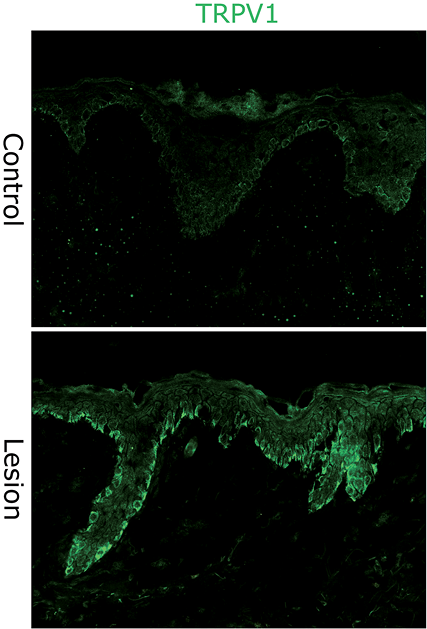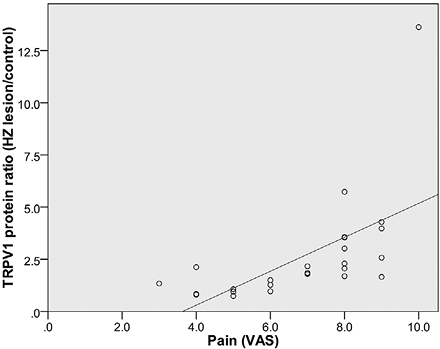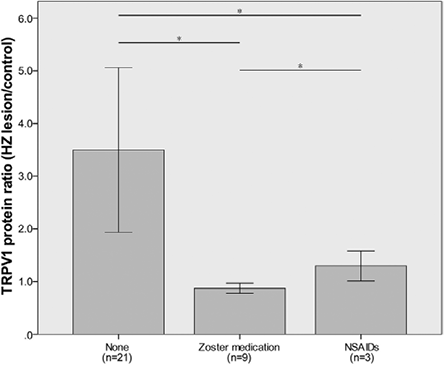Sang Bum Han1–3, Hyeree Kim4, Sang Hyun Cho4, Jeong Deuk Lee4, Jin Ho Chung1–3 and Hei Sung Kim4
1Department of Dermatology, Seoul National University College of Medicine, 2Laboratory of Cutaneous Aging Research, Clinical Research Institute, Seoul National University Hospital, 3Institute of Dermatological Science, Seoul National University, Seoul, and 4Department of Dermatology, Incheon St Mary’s Hospital, College of Medicine, The Catholic University of Korea, Incheon, Korea
The role of transient receptor potential vanilloid-1 (TRPV1) in the initiation of neurogenic inflammation and transduction of pain is well established. In this study 33 patients with herpes zoster (HZ) were recruited from a single centre and underwent a questionnaire interview at their first visit. Punch biopsies from the HZ lesions and the contralateral unaffected skin were performed to localize and quantify the expression of TRPV1. Immunofluorescent staining for TRPV1 was most prominent in the epidermal keratinocytes. Both TRPV1 mRNA and protein levels were significantly higher in the HZ epidermis than in control epidermis (relative ratio 1.62 ± 0.27, p = 0.033 and 2.55 ± 0.51, p = 0.005, respectively). Protein TRPV1 ratio (HZ lesion/control) correlated with the degree of pain (measured on a visual analogue scale; VAS) (p = 0.017) and was significantly lower in patients who had taken either HZ medication or painkillers prior to their visit. These results suggest that non-neuronal TRPV1 may contribute to acute pain in herpes zoster. Key words: transient receptor potential vanilloid-1; acute pain; herpes zoster.
Accepted Sep 16, 2015; Epub ahead of print Sep 22, 2015
Acta Derm Venereol 2016; XX: XX–XX.
Hei Sung Kim, Department of Dermatology, Incheon St. Mary’s Hospital, The Catholic University of Korea, Dongsuro, Bupyeong-gu, 150-713 Incheon, Korea. E-mail: hazelkimhoho@gmail.com
Varicella zoster virus (VZV) causes varicella (chickenpox) on primary infection and herpes zoster (HZ) (shingles) following reactivation from a neuronal latent state established during the primary infection. The incidence of HZ is high, with an estimated lifetime risk of 30% in the general population and > 50% in people > 85 years of age (1).
Zoster-associated pain and post-herpetic neuralgia (PHN) are common and highly distressing complications of HZ that remain a significant public health concern and require improved therapies (2, 3). Only 30–50% of patients with PHN obtain more than 50% pain relief with any treatment (4). Improved understanding of the pathophysiology of pain would enable the selection of appropriate treatment strategies to minimize zoster pain.
HZ is accompanied by skin inflammation. Clinically, HZ manifests as a painful dermatomal skin rash, representing neuronal delivery of the virus to the skin from an adjacent sensory ganglion (5, 6). Here, the VZV is thought to “trigger” skin cells to produce a variety of inflammatory cytokines, some of which cause vasodilation. The inflammation also activates nerve cells, contributing to zoster pain.
The transient receptor potential vanilloid-1 (TRPV) family consists of 4 non-selective cation channels (TRPV1, TRPV2, TRPV3 and TRPV4) and 2 highly Ca2+-selective channels (TRPV5 and TRPV6) (7). Among the receptors, TRPV1 is ubiquitous on neuronal cells and has an important role in pain and neurogenic inflammation (8–11). With TRPV1 being linked to the key features of HZ, we postulated the receptor to play a role in the pathophysiology of this disease.
The aim of this study was to localize and quantify the expression of TRPV1 in HZ skin lesions and relate TRPV1 to HZ severity, especially to acute zoster pain.
MATERIALS AND METHODS (see Appendix S11)
RESULTS
Patient characteristics
A total of 33 patients with HZ (21 women, 12 men) completed the study. Table SI1 summarizes the basic characteristics of the participants. The mean age of the study participants was 58 years (range 24–88 years). The patients were categorized into 5 age groups: < 50 years (21.2%); 50–59 years (33.3%); 60–69 years (15.2%); 70–79 years (18.2%); and ≥ 80 years (12.1%).
On average, the pain started 6 ± 3 days before the first visit, whereas the skin rash appeared 5 ± 2 days prior to the first visit. The primarily affected dermatome was thoracic (42.4%), followed by trigeminal (24.2%), cervical (12.1%), lumbar (12.1%) and sacral (9.1%). Twenty-four patients had an underlying disease, including hypertension (30.3%), diabetes mellitus (15.2%), vascular disease (6.1%) and malignancies (18.2%).
The mean ± standard deviation (SD) of HZ skin lesion severity was 6.30 ± 1.86 at the first visit. The mean ± SD of initial pain intensity and Self-completed Leeds Assessment of Neuropathic Symptoms and Signs pain scale (S-LANSS) were 6.64 ± 2.33 and 17.64 ± 5.44, respectively.
Out of the 33 patients, 12 (36.4%) had a medication history of antiviral and painkillers. Nine were on HZ medication (containing oral antiviral) before their first visit for a mean of 4.1 days (range 2–6 days). Three patients only took painkillers (2 took non-steroidal anti-inflammatory drugs (NSAIDs) to control zoster-associated pain and one was on NSAIDs for her rheumatoid arthritis). All medications were confirmed by checking the prescription receipt.
Three patients were in significant pain at 3 months follow-up and were categorized as PHN.
TRPV1 expression in HZ skin lesions and control skin
Immunofluorescent (IF) staining of the control skin showed weak TRPV1 immunoreactivity throughout the epidermis with a relatively stronger expression in the stratum corneum (SC) and the basal keratinocytes (KCs). TRPV1 expression was increased in the HZ lesions compared with control skin. Within the epidermis of the HZ lesions, TRPV1 immunoreactivity was most prominent in the basal KCs (Fig. 1). Both TRPV1 mRNA and protein levels were significantly higher in HZ lesions (epidermis) compared with their unaffected counterparts, with a relative ratio (RR) of 1.62 ± 0.27 (p = 0.033) and 2.55 ± 0.51 (p = 0.005), respectively.

Haematoxylin and eosin staining and cytokine expression in herpes zoster lesions
Dense inflammation was a common finding in the HZ skin lesions. Tumour necrosis factor alpha (TNF-α) and interleukin (IL)-1ß mRNA were significantly higher in HZ lesions than control skin, with a RR of 4.28 ± 1.01 (p = 0.004) and 30.0 ± 12.7 (p = 0.044), respectively. Both cyclooxygenase (COX)-1 and COX-2 mRNA levels were increased in HZ lesions, with a RR of 3.67 ± 1.13 (p = 0.029) and 2.04 ± 0.62 (p = 0.004), respectively. IL-8 was also prominently higher in the HZ lesions (RR: 14.0 ± 4.71, p = 0.008) (Table I).
Table I. Cytokine levels in herpes zoster (HZ) skin lesions (expressed in ratios over control skin). SD: standard deviation
|
HZ epidermis/control Mean ± SD |
p-value |
|
|
Tumour necrosis factor-α mRNA |
4.28 ± 1.01 |
0.004 |
|
Interleukin-1ß mRNA |
30.01 ± 12.7 |
0.044 |
|
Cyclooxygenase-1 mRNA |
3.67 ± 1.13 |
0.029 |
|
Cyclooxygenase-2 mRNA |
2.05 ± 0.62 |
0.004 |
|
Interleukin-8 mRNA |
14.1 ± 4.71 |
0.008 |
Relationship between protein TRPV1 ratio, pain, zoster skin severity score and S-LANSS
The relationship between protein TPRV1 ratio (HZ lesion/control), pain, zoster skin severity score and S-LANSS was analysed using Spearman’s rank correlation analysis. Among the factors, there was positive correlation between protein TRPV1 ratio and pain (r = 0.465, p = 0.017) (Fig. 2), protein TRPV1 ratio and S-LANSS (r = 0.399, p = 0.044) and between pain and S-LANSS (r = 0.405, p = 0.019). No correlations were found among the other variables.

Relationship of protein TRPV1 ratio, pain and S-LANSS with age, sex, zoster location and medication history
The relationship of protein TRPV1 ratio, pain and S-LANSS with age, sex, zoster location and medication history (i.e. antiviral and painkillers) were analysed. Among the factors, protein TRPV1 showed inverse correlation with medication history, being significantly lower in those with a medication history (p = 0.015). Protein TPRV1 ratio between the 3 following groups were further compared: (i) “no medication group” (those who were not exposed to any antiviral or painkillers before their first visit); (ii) “HZ medication group” (those who were on antiviral medication); (iii) “NSAIDs group” (those who have taken NSAIDs only) to find statistical difference between all groups (Fig. 3). Pain and S-LANSS were not affected by medication history and there was no correlation among the other variables.

DISCUSSION
TRPV1 has been purported to be expressed exclusively on polymodal primary sensory neurones, the location of which is clearly linked with its role in pain and neurogenic inflammation. However, evidence has also located TRPV1 on a variety of non-neuronal tissues (15–19). In the zoster lesions, TRPV1 was expressed mainly on epidermal KCs under IF staining. In addition, quantitative real-time PCR (qRT-PCR) and Western blot analysis showed higher levels of TRPV1 protein and mRNA in the lesional epidermis compared with the contralateral, unaffected skin, implying significant involvement of TRPV1 in KCs in the pathophysiology of HZ.
The mechanism of pain in HZ is complex and remains poorly defined. It is currently assumed that a combination of nociceptive (tissue damage and inflammation) and neuropathic (peripheral nerve damage) pain contribute to acute zoster pain, whereas central sensitization and structural changes, acquired during the acute phase, results in PHN (20). Nociceptors are specialized nerve endings that respond to “normal” pain-producing stimuli, such as thermal, chemical, or mechanical irritants that cause tissue damage (2). Nociception is augmented by the release of pro-inflammatory agents, such as cytokines and prostanoids, which can alter or sensitize neural transmission and create a temporary state of neuropathic pain (20, 21).
KCs play an important role in maintaining the integrity of the immune response in skin, as well as stimulating cutaneous inflammation via prostanoid and cytokine release (22). TRPV1 activation by capsaicin was shown to increase COX-2 expression in human KCs, with a concomitant rise in prostaglandin (PG) E2 levels in vitro (23). Similarly, treatment of human KCs with TRPV1 agonist reportedly heightened the expression of pro-inflammatory IL-1 (24). The HZ lesions from our study showed dense inflammation and higher levels of TNF-α, IL-1ß, COX, and IL-8 mRNA compared with their contralateral unaffected skin. Inflammatory mediator release from KCs can affect the sensory nerves in skin, especially as PGE2 and IL-1 are known to sensitize and activate sensory nerve endings (25, 26). Through this interaction, we believe KCs TRPV1 contributes to acute zoster pain.
Pain showed a positive correlation with both TRPV1 and S-LANSS in our study, which supports the assumption that acute zoster pain is a combination of nociceptive (inflammatory) and neuropathic pain. In addition to its contribution to inflammation and nociceptive pain, protein TRPV1 has shown correlation with S-LANSS, which suggests TRPV1 involvement in neuropathic pain.
Noticeably, protein TRPV1 ratio was highly influenced by the use of antivirals and NSAIDs. According to our study results, protein TRPV1 level was significantly lower in those with the medication history. There have been some supportive data on this subject, where aggressive management of acute HZ with antiviral medication was shown to shorten the duration of the skin rash and acute zoster pain by limiting viral replication and spread (27). NSAIDs are known to prevent the sensitization of TRPV1, and its conjugated forms have been reported to inhibit TRPV1 (28, 29). Acetylsalicylic acid has also been shown to inhibit the capsaicin- and heat-induced responses in cultured dorsal root ganglia neurones, posing TRPV1 as an additional target (30). To note, the duration of pain between the “no medication group” and the “medication group (HZ medication + NSAIDs alone)” was statistically similar, eliminating the effect of a confounding factor (time) on TRPV1.
Interestingly, unlike protein TRPV1, the degree of zoster-associated pain was not affected by the medication history in our study patients. This may be explained by the fact that patients with more severe pain take medication earlier on. That is, patients in the “medication group” have probably experienced stronger pain.
In conclusion, these results suggest that epidermal TRPV1 plays a key role in HZ, contributing to zoster-associated pain largely through inflammation and possibly through peripheral nerve sensitization, which in turn needs confirmation by assessing the innervation density of the epidermis. Both antiviral medication and analgesics proved effective in lowering epidermal TRPV1 and should be beneficial in reducing acute zoster pain. The study points to an extended role of TRPV1 in the spectrum of painful skin diseases and the potential of anti-TRPV1 treatment as a novel therapy for HZ.
ACKNOWLEDGEMENTS
The authors wish to acknowledge financial support from the Catholic Medical Center Research Foundation, made in the programme year 2013, and the grant from the Dermatology Alumni Fund of the Catholic University of Korea, made in the programme year 2012.
This study was also supported by the grant from the Korea Health Technology R&D Project through the Korea Health Industry Development Institute (KHIDI), funded by the Ministry of Health & Welfare, Republic of Korea (grant number: HI14C1277).
The authors declare no conflicts of interest.

1http://www.medicaljournals.se/acta/content/?doi=10.2340/00015555-2247
REFERENCES
